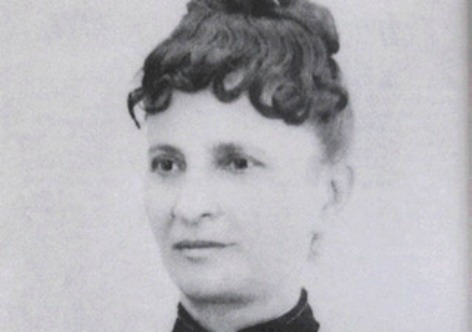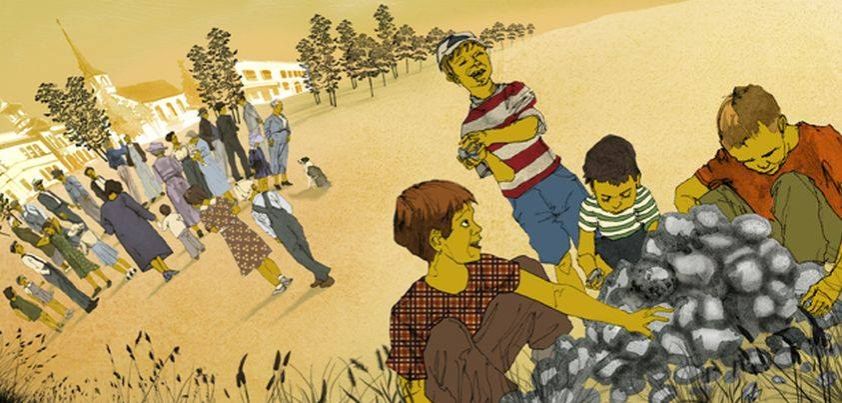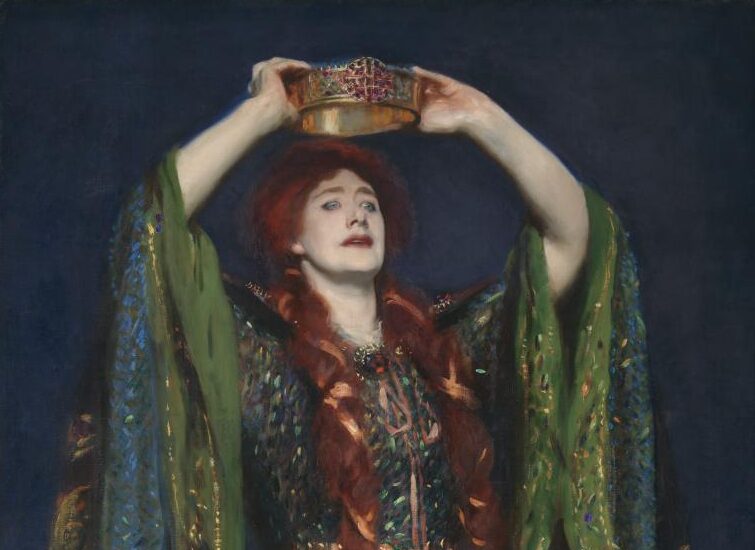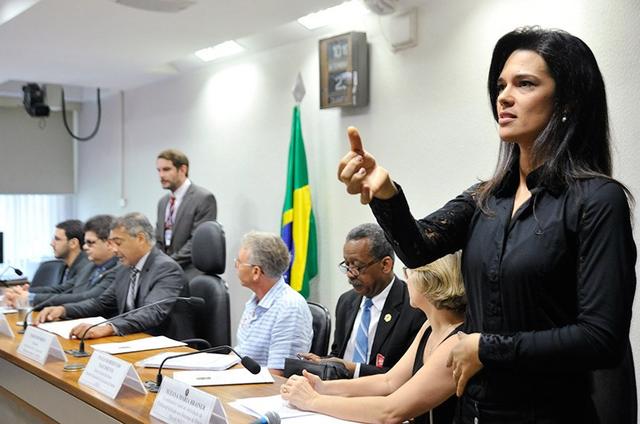Por Débora Klug
Bolsista PET – Letras
Letras – Português
Em Roma, nos anos 1950, havia fiscais em frente às tabacarias aos domingos, para regular a venda exclusiva do tabaco, e de nenhum outro produto além desse. A razão dessa imposição não é clara. Ao menos, aqueles que tinham gosto pela substância não corriam o risco de sofrer a abstinência dominical. É no cenário de uma tabacaria cheia em um domingo, e de um fiscal enganado, que inicia o processo de transgressão de Valeria, uma mulher de 43 anos, casada e com dois filhos. Saiu em um domingo de manhã para comprar as flores decorativas da mesa da cozinha e charutos para o marido, Miguel, antes que esse acordasse. Cadernos de capa preta, como aqueles que se levava para a escola, estavam expostos perto do caixa da tabacaria, e logo despertam o interesse da mulher. Ela compra um caderno, um pouco a contragosto do vendedor, que indica o fiscal na porta da loja, mas vende mesmo assim. Valeria sai com o caderno escondido embaixo do casaco, imaginando escrever seu nome em letras grandes e legíveis na primeira folha, como fazia quando criança, com os cadernos da escola.
É assim que começa o livro Caderno Proibido, de Alba Céspedes, publicado originalmente em 1952. Esse caderno se tornará o diário de Valeria, em um movimento de libertação e culpa , durante a tomada de consciência da sua condição como mulher na sociedade.

Descrição da imagem: Do lado esquerdo há a imagem em preto e branco de uma mulher branca, com cabelo curto, acendendo um cigarro. Está com um óculos de armação escura, os dedos são adornados por anéis, e o braço esquerdo por um bracelete. Veste uma camisa com babados brancos e um casaco ou blazer escuro. Essa mulher é Alba de Céspedes. Do lado direito da imagem, em um fundo vermelho, observa-se a capa de um livro. Nela, há a imagem do busto de uma mulher sentada, utilizando uma camisa de botão. Ela possui cabelos até os ombros. Seu rosto está coberto pelo nome do livro, em um quadro azul escuro com uma fina borda vermelha, escrito “Caderno Proibido” em letras maiúsculas; logo abaixo “Alba de Céspedes”. Ao fundo há almofadas listradas, e um quadro de uma árvore pendurado na parede.
É interessante perceber que o livro todo se estrutura como um diário. A narração, portanto, é em primeira pessoa, o que aproxima o leitor da mente da personagem, e permite acompanhar juntamente com Valeria seu processo de escrita de si. A personagem possui sentimentos conflituosos pelo caderno. Ao mesmo tempo que é atraída por ele, tem um interesse em escrever, ela também sente que é algo errado. A frase inaugural do livro (e do diário) é a seguinte “Fiz mal em comprar este caderno, muito mal. Mas agora é tarde demais para lamentar, o estrago está feito. ” (De Céspede 1962, p. 1).
Antes mesmo de começar a escrever, ela precisa urgentemente esconder o caderno, mas não sabe onde. Se os filhos ou o marido acharem vão tomar para si, e não havia a possibilidade de ela atestar a posse do caderno, pois seu desejo de escrever não seria levado em consideração.
No processo de tentar esconder o caderno, Valeria percebe que não possui um espaço da casa que seja seu. Mirella, a filha, tem um quarto e em uma gaveta chaveada guarda seus pertences particulares; Ricardo, o filho mais velho, possui também um quarto só seu e sempre utiliza a única escrivaninha da casa para estudar; Valeria ainda compartilha com o marido o quarto e não há delimitação dos espaços de cada um. Então, resta-lhe um saco na cozinha onde se guarda os trapos para limpeza. Um lugar que só ela acessa, pois é a única da casa que realiza os serviços domésticos: um símbolo do lugar da mulher na sociedade. Um lugar submisso, legado aos trabalhos domésticos.
À Valeria era reservado o lugar de esposa, mãe e cuidadora da casa. Mas nunca um lugar onde poderia desenvolver uma subjetividade. A todo momento relata sentir culpa. Como se fizesse algo errado ao escrever. Como se não estivesse sendo útil. Como se perdesse tempo. Mas é no ato da escrita que a mulher lentamente percebe sua condição, percebe que não havia justiça ali, e tem um novo olhar sobre as situações hodiernas. Com o tempo, Valeria escreve cada vez mais. O que antes eram poucos minutos escrevendo, se torna mais de um momento por dia dedicado à escrita. Mas escrever é um ato sempre realizado às escondidas. Valeria passa noites em claro para escrever sem ser perturbada.
O exercício de escrever no diário, nesse sentido, é um exercício de tomada de consciência. É uma tomada de consciência das ações cotidianas. O que se escreve, de acordo com Blanchot (2005), passa a se enraizar no cotidiano, e na maneira como se enxerga o cotidiano.
O diário íntimo, que parece tão livre de forma, tão dócil aos movimentos da vida e capaz de todas as liberdades’ já que pensamentos, sonhos, ficções, comentários de si mesmo, acontecimentos importantes, insignificantes, tudo lhe convém, na ordem e na desordem que se quiser, é submetido a uma cláusula aparentemente leve, mas perigosa: deve respeitar o calendário. Esse é o pacto que ele assina. O calendário é seu demônio, o inspirador, o compositor’ o provocador e o vigilante. Escrever um diário íntimo é colocar-se momentaneamente sob a proteção dos dias comuns, colocar a escrita sob essa proteção, e é também proteger-se da escrita, submetendo-a à regularidade feliz que nos comprometemos a não ameaçar. O que se escreve se enraíza então, quer se queira, quer não, no cotidiano e na perspectiva que o cotidiano delimita. (Blanchot, 2005, p. 270).
É na inscrição desse ritual cotidiano, ao se submeter ao calendário provocador e vigilante, que a transformação em Valeria passa a ocorrer, de maneira controversa, com culpa e por vezes sem felicidade.
São duas da madrugada, levantei para escrever, não conseguia dormir. A culpa, mais uma vez é deste caderno. Antes, eu esquecia rápido o que acontecia em casa; mas agora, desde que comecei a anotar os eventos cotidianos, mantenho-os na memória e tento compreender por que se produziram. Se é verdade que a presença oculta desse caderno dá um sabor novo à minha vida, devo reconhecer que não serve para torná-la feliz. (De Céspedes, 2022. p. 23)
Quanto mais Valeria se percebe no mundo (através da escrita revela sua subjetividade), mais desejo tem de escrever, de enfrentar os dilemas e contradições que vive. Ela passa a sonhar intensamente em ter um espaço seu, para que possa escrever. Um cubículo que seja, qualquer lugar que seja possível pensar. Alegoricamente, esse cubículo é como um simulacro de interioridade, um local onde todos os pensamentos e sentimentos possam se alojar, mesmo que desordenados. Um lugar recluso, sem perturbações, onde Valeria poderia elaborar o que ela quer dizer, e dizê-lo.
Às vezes eu precisaria ficar sozinha; […] sonho ter um quarto só para mim […] Eu me contentaria com um cubículo. No entanto, jamais consigo me isolar, e só renunciando ao sono é que encontro um tempinho para escrever aqui. Se, quando estou em casa, interrompo o que estou fazendo, ou à noite, na cama, paro de ler e olho o vazio, há sempre alguém que pressurosamente me pergunta em que estou pensando. (De Céspedes), 2022. p. 71-2)
Ressoa nessa passagem algo dito anos antes, em 1928, em duas conferências na Universidade de Cambridge. O tema em questão era o papel das mulheres na ficção literária, e a convidada era Virginia Woolf. As conferências e dois artigos escritos pela autora resultaram no livro Um teto todo seu, publicado originalmente em 1929. No primeiro capítulo, Woolf defende que as mulheres não estão presentes no cânone literário, e não escrevem tantas obras de ficção comparadas aos homens pois “[…] a mulher precisa ter dinheiro e um teto todo seu se pretende mesmo escrever ficção; e isto, como vocês vão ver, deixa sem solução o grande problema da verdadeira natureza da mulher e da verdadeira natureza da ficção” (Woolf, 2004, p. 8). Ou seja, para as mulheres escreverem precisam de um lugar onde possam de fato exercer a escrita, uma atividade que exige concentração, reflexão e tempo. Para isso é necessário recursos financeiros. Se a natureza das mulheres era casar, ter filhos e cuidar da casa, onde e quando poderiam escrever? E a produção de ficção literária seria, portanto, de natureza masculina? Woolf escreveu na década de 1920, e De Céspedes em 1950, quarenta anos de diferença, e as condições da mulher não mudaram muito.
É interessante pensar que, a partir da afirmação de Woolf, entendemos que escrever também é um trabalho. Supera a ideia de que um escritor deve-se valer de inspiração, talento ou algo de natureza ininteligível. É um exercício sobre a linguagem e com a linguagem. Uma mulher é tão capaz de fazê-lo quanto um homem, se dadas as condições para tal, se para ela for possível desenvolver sua habilidade com a escrita.
O diário, apesar de ser perturbador (com um traço demoníaco, como diria Blanchot) e apesar de muitas vezes trazer angústia para Valeria, também a leva ao momento em que se olha no espelho, se reconhece em seus traços, em sua pele, e sente alegria. Nesse momento se materializa em reflexo e em sentimento o ato da escrita como radical tomada de consciência de si. Antes do diário, Valeria parecia não saber se reconhecer no mundo verdadeiramente. É a partir da ruptura que a escrita de si incita, através da elaboração dos relatos e pensamentos de seu cotidiano, que ela percebe quem é e quem pode ser. É em sua própria vivência, e a partir de sua própria vivência, que ela cria sua subjetividade e reconhece sua presença potente no mundo.
REFERÊNCIAS
BLANCHOT, Maurice. O livro por vir. São Paulo: Martins Fontes, 2005.
DE CÉSPEDES, Alba. Caderno proibido. Rio de Janeiro: Editora Companhia das Letras, 2022.
WOOLF, Virginia. Um teto todo seu. São Paulo: Tordesilhas, 2014.

















